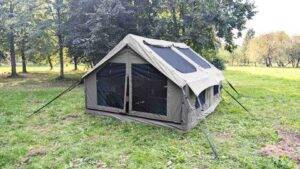

Efficient, Eco-Friendly, And essential: 10 Tools To Put On Your Backpacking Checklist In 2019
Backpacking isn’t a minimalist pastime anymore. Before embarking on your adventure, here are some new essential tools to add to your backpacking checklist.
Ready to head into the backcountry for a day hike or an overnight trip with Mother Nature? First, you’ll need the essential hiking gear and a backpacking checklist. Even on a routine trip, you’ll want your outdoor essentials nice and in order.
Here are 10 items you will want on your backpacking checklist. In case something were to go wrong, you’ll appreciate having your backpacking gear on you. Having some of these items are essential to your survival.
Sun Protection
Your backpacking checklist should always have sunglasses, sunscreen, and sun-protection clothing. Avoiding this can result in snow blindness and/or sunburn. Long term, not having these hiking essentials could cause skin aging, skin cancer and more.
Sunglasses: A quality pair of sunglasses will protect your eyes from damaging radiation. If you plan on traveling on snow or ice for an extended time, you’ll want extra-dark glacier glasses. Choose sunglasses with 100 percent UVA and UVB blocking.
Sun-protection clothing: Clothing is an effective way to block UV rays from your skin. There are lightweight, synthetic clothing pieces with an ultraviolet protection factor (UPF). This indicates how effective the clothing is against UVA and UVB light.
Sunscreen: Spending a lot of time outside exposes you to ultraviolet rays that can cause sunburn, skin aging, and other threats to your health. You’ll need sunscreen to help limit that exposure. Choose a sunblock with at least a sun protection factor (SPF) of 15 through SPF 30.
You could also learn how to use the sun’s rays to generate power with sources like https://PoweredPortableSolar.com.
First-Aid Kits
First-aid must be apart of your hiking essentials to protect you from the unexpected. You can personalize a pre-assembled first-aid kit to suit your backpacking needs. However, each kit should include adhesive bandages, blister treatment, gauze pads, disinfecting ointment, adhesive tape, over-the-counter-medication, and writing utensils.
A Headlamp
Finding your way through the dark can be intimidating. Flashlights are useful but a headlamp should be in every hiking kit. It keeps your hands free and runs on batteries.
Navigation Tools
Modern navigation tools considered to be essential hiking gear include a map, compass, GPS device, and a personal locator beacon (PLB). Take a look at these:
Map: A topographic map on any trip is helpful for any nature trail. These are great for those footpaths that are impossible to miss or for a route you frequent. Learning how to read a topo map is simple and easy.
Compass: A compass and a savvy map-reader is the ideal combination. It is a vital tool if you ever end up lost or confused in the backcountry. Smartphones, GPS devices and watched have electronic compasses but having a backup is key. A standard baseplate compass is lightweight and does not depend on batteries.
Compasses built with a sighting mirror can also help flash sunlight to a rescuer or helicopter during an emergency. Making a compass essential backpacking gear.
GPS device: GPS provides you with an accurate location on a digital map. The devices designed for outdoor travel are often waterproof and built rugged. Smartphones offer a GPS app but you’ll likely need a protective case to keep it safe.
Personal locator beacon (PLB): These devices are best to alert emergency respondents. Once activated, they can determine your exact position using GPS. They will then send a message through the government or commercial satellites.
Packing Knives
Knives work well for repairing your gear, preparing your food, first aid, and other important factors. Every person in your hiking group should pack a knife. They are essential hiking gear to have.
Basic knives have a single foldout blade and more complex knives include other useful parts. If your needs are more complex, you’ll find more use with a multi-purpose knife. Some have one or two flathead screwdrivers, a pair of foldout scissors, and a can opener.
A Firestarter
Having reliable supplies for starting and maintaining a fire are outdoor essentials. This may include matches or a disposable butane lighter. You should also store either in a waterproof container.
The best firestarter tool ignites quickly and sustains heat for a good amount of time. Dry tinder in a plastic bag, priming paste, candles, heat “nuggets” are all great options. These can be used as an emergency heat source when firewood is not available.
Emergency Shelter
You should always have some kind of emergency shelter for protection. In case you get injured on a trail or stranded, you’ll need a safe space to retreat to. You can buy an ultralight tarp, an emergency space blanket, a bivy sack or even a big plastic trash bag.
More Food
In case something causes your trip to go longer than planned, pack an extra day’s worth of food. Avoid packing items that require cooking or don’t have a long shelf life. Some options are energy bars, dried fruits, nuts or jerky.
Or if you’re heading on a long multi-day hike or winter trek, plan on bringing more than a one-day supply.
Extra Water
Backpacking gear should always include having enough water and having a way to treat water. You could have a filter/purifier, a stove to melt snow or chemical treatment. You should consider that people need at least a half-liter of water per hour during average temperatures and conditions.
Always have at least one bottle of water or a collapsible water reservoir. You should fill this up from a potable water source at the start of your journey.
Additional Clothing
Outdoor trekking conditions can change abruptly so it is necessary that you have extra clothes on your journey. Consider what you would need to survive through wet, chilly or windy conditions. Keep in mind that you could be in these conditions for a long, inactive period.
A few hiking essentials include an insulating hat, a layer of underwear, extra gloves, extra socks, and a synthetic vest or jacket. For winter trekking, bring insulation for your legs and upper body.
Start Your Backpacking Checklist Today
The exact items for your backpacking checklist can be customized for your trip. When selecting what to bring, consider factors like duration, difficulty, weather, and distance from help. You can start with the items on this list and continue adding what you need to make your next journey your best one yet!
For more information on what makes essential hiking gear, check out more right here on our blog!







